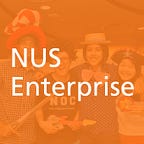Fundraising 101: tips for early starters
THE HANGAR Booster Programme highlights: What is Fundraising?
Contributed by Rebecca Tan Li Qi
Funding (or rather sufficient funding) is usually the top priority for start-ups. Even if there is an intention to bootstrap at an earlier stage of growth, raising funds is often required for scaling in the long run. The question is, how should founders pitch to get funding successfully?
This week, I popped into one of the workshops of THE HANGAR Booster Programme and learned interesting tips from Dr Ivan Choong, Associate Director at NUS Enterprise, who is also part of the Portfolio team.
The fundamental question to ask ourselves is, what matters to investors?
Investors pay attention to a start-up’s technical and investor readiness. Technical readiness is the bread and butter of your start-up. To have a gauge of your start-up’s technical readiness, refer to the infographic below:
To test if you are investor-ready, ask yourself the following questions:
- Can you answer strategic questions like what metrics have you measured to prove that there is a demand for your product?
- Can your financial plan convince investors?
- Can you explain the valuation of your start-up?
Other than technical and investor readiness, investors also greatly value passionate founders and effective team dynamics. They are investing more in people than in your products or services, especially at early-stage funding. The team’s or founder’s potential plays a paramount role in the investors’ decision to invest in your start-up.
What are some common terminologies used in fundraising then?
- Pre-money valuation: the value of your start-up before it receives investments
- Post-money valuation: the value of your start-up after it receives investments (AKA pre-money valuation + investments)
- Drag along rights: rights that allow majority shareholders to force the minority shareholders to sell their shares
- Tag along rights: rights that allow minor shareholders to tag along when the major shareholder(s) decide(s) to sell their shares
- ESOP (Employee Stock Ownership Plan): employee benefit plan that gives workers equity shares of a start-up
- Share Cap Table: a spreadsheet that shows the equity ownership of a start-up
So, what are some tips for raising funds?
- Look for investors who share the same values as you
- Focus on building rapport with your potential investors
- Establish proper financial data first before approaching investors for negotiation
- Be strategic in who you pursue funds from (preferably less from angel investors and more from venture capitalists)
- Be careful of how much equity you give to investors
Final pro-tip learnt? — As there is no guaranteed ticket to success, just take the journey!
—
Want to take your start-up to the next level but missed the application for this run? Reach out to us at enterprise@nus.edu.sg to find out more about our next run in October 2021!
